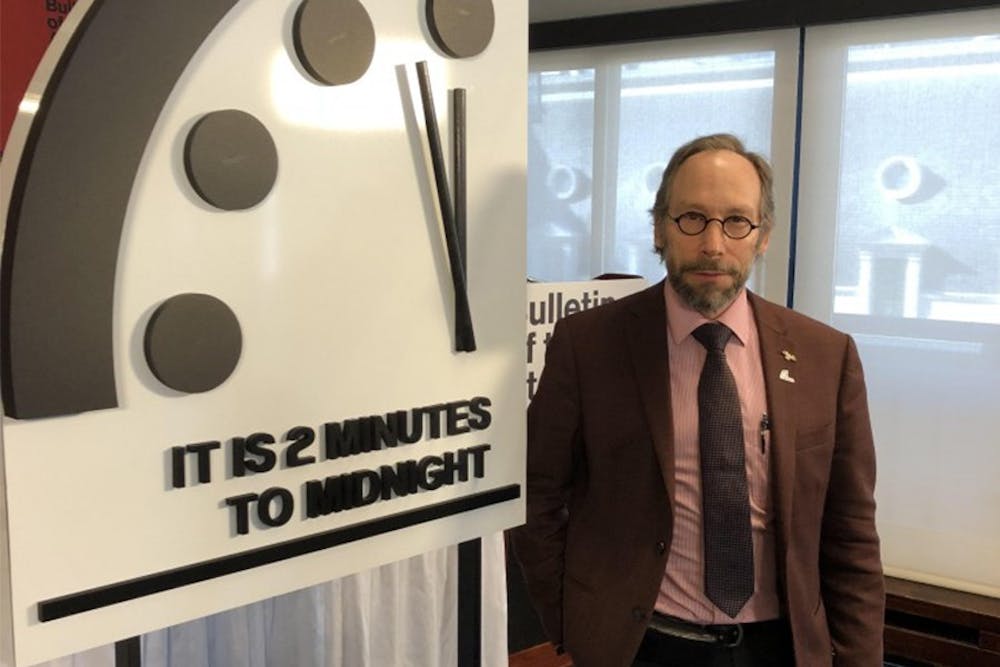Society is teetering on the edge of global catastrophe according to ASU foundation professor Lawrence Krauss and other scientists who moved the Doomsday Clock to two minutes to midnight.
The Bulletin of the Atomic Scientists' Science and Security Board held discussions and voted to move the minute hand 30 seconds closer to midnight on the Doomsday Clock, which is a symbol of global destruction.
The scientists’ reasoning was laid out in a statement issued last Thursday. Their concerns ranged from nuclear weapon stockpiles to North Korea to inaction by governments in reducing planet-warming carbon emissions.
Krauss, director of the ASU Origins Project and renowned theoretical physicist, is the chair of the Bulletin’s Board of Sponsors.
Krauss didn't have a vote on the decision, but he contributed in the talks toward the decision, and the Bulletin's editor-in-chief John Mecklin said Krauss' opinion was highly regarded in the discussion.
Krauss said there are more threats, nuclear and otherwise, to humanity now than there were at the peak of the Cold War.
“There are many more countries that possess nuclear weapons now than there were in 1953, when it was just the U.S. and Russia,” Krauss said. “We have many more existential threats that technology has placed in humanity.”
Krauss said that the lack of political will to address global problems has led to a situation where the world is becoming more dangerous.
“I think that because the world hasn’t acted on the concerns we’ve had over the last few years, things are not getting safer,” Krauss said.
Mecklin said that following a trend of denuclearization in the 1980s, the world’s governments have reverted to stockpiling nuclear weapons.
“It appears like the world is embarking once again on another arms race just after everybody had agreed, ‘well that’s crazy',” Mecklin said.
He said many young people don’t understand how dangerous the current nuclear situation is.
“There is a real danger,” Mecklin said. “We’re spending a trillion dollars on massive amounts of weapons that can’t possibly be used. If 200 of them are used around the world, the world goes into nuclear winter and essentially everybody dies.”
David Titley, a retired rear admiral in the U.S. Navy and meteorology professor at Penn State, is a member on the board that discussed the Doomsday Clock.
“We have tried to take very complex things… and summarize it in something as simple as a clock,” Titley said.
He said the communication between North Korea and the U.S. was worrisome.
"One of the things we say is that it’s really very unhelpful to have the leaders of the United States and the leaders of North Korea trading Twitter insults at each other, so that should stop."
Alongside nuclear and security problems, the lack of substantive policies to reduce greenhouse gases moved the Clock closer to midnight.
Titley said that global warming has caused noticeable changes in severe and unusual weather events.
“If you go to California and talk about how these wildfires seem to be changing, they’re lengthening, they are becoming more severe,” Titley said. “Hurricane Center just put out the damage totals ... $265 billion for Harvey, Irma and Maria combined. So nearly a third of a trillion dollars. That tends to get people’s attention.”
Titley said that despite the efforts by some to discredit climate scientists, he thinks "the facts on the ground are seeping into the consciousness."
Krauss, Titley and Mecklin all individually said that young people can help wind the clock back by becoming informed on the issues and being civically active.
"The first thing they can do is educate themselves," Krauss said. "Which is one of the reasons the Bulletin exists online, (it) is to provide really informative material on these issues so people can separate fact from opinion."
Reach the reporter at cscragg@asu.edu or follow @monsoonchaser on Twitter.
Like State Press on Facebook and follow @statepress on Twitter.




